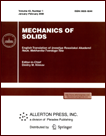 | | Mechanics of Solids
A Journal of Russian Academy of Sciences | | Founded
in January 1966
Issued 6 times a year
Print ISSN 0025-6544
Online ISSN 1934-7936 |
Archive of Issues
| Total articles in the database: | | 13288 |
| In Russian (Èçâ. ÐÀÍ. ÌÒÒ): | | 8164
|
| In English (Mech. Solids): | | 5124 |
|
| << Previous article | Volume 60, Issue 2 / 2025 | Next article >> |
| Dongquan Wu, Wenjie Wu, Enze Wu, Lianpeng Lu, and Dizhi Guo, "Analysis of Creep Crack Growth Based on New Multiaxial Ductility Factor and Creep-Damage Model," Mech. Solids. 60 (2), 1446-1468 (2025) |
| Year |
2025 |
Volume |
60 |
Number |
2 |
Pages |
1446-1468 |
| DOI |
10.1134/S0025654425600229 |
| Title |
Analysis of Creep Crack Growth Based on New Multiaxial Ductility Factor and Creep-Damage Model |
| Author(s) |
Dongquan Wu (Sino-European Institute of Aviation Engineering, Civil Aviation University of China, Tianjin, 300300 China, dqwu@cauc.edu.cn)
Wenjie Wu (Sino-European Institute of Aviation Engineering, Civil Aviation University of China, Tianjin, 300300 China)
Enze Wu (Sino-European Institute of Aviation Engineering, Civil Aviation University of China, Tianjin, 300300 China)
Lianpeng Lu (Sino-European Institute of Aviation Engineering, Civil Aviation University of China, Tianjin, 300300 China)
Dizhi Guo (Sino-European Institute of Aviation Engineering, Civil Aviation University of China, Tianjin, 300300 China) |
| Abstract |
In this study, the multiaxial ductility factor and creep damage model were analyzed based on the power-law creep grain-boundary cavities growth theory under multiaxial stress states. Theoretical cavities growth rates under multiaxial stress state were discussed and the predicting model of stress-state parameter α was revised by using an empirical fitting expression denoted as αNEW, then a new empirical predicting model of multiaxial ductility factor MDFNew was established which involving multiaxial parameter αNew and uniaxial parameter α0. Besides, a novel creep constitutive model considering the damage parameter was also be established, which could correctly describe the whole period of creep regime, especially the tertiary period. Finally, the damage process was analyzed by using finite element method with this novel creep damage model, and the FE results of the load line displacement and crack growth predictions coincide well with experimental observations. |
| Keywords |
multiaxial ductility factor, cavities growth theory, creep damage, finite element method |
| Received |
18 January 2025 | Revised |
18 March 2025 | Accepted |
18 March 2025 |
| Link to Fulltext |
|
| << Previous article | Volume 60, Issue 2 / 2025 | Next article >> |
|
 If you find a misprint on a webpage, please help us correct it promptly - just highlight and press Ctrl+Enter If you find a misprint on a webpage, please help us correct it promptly - just highlight and press Ctrl+Enter
|
|

 Russian
Russian  English
English